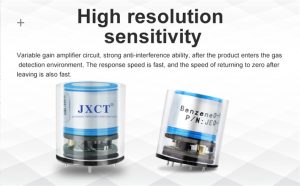Gas monitor sensors play a crucial role in ensuring safety in various industries and environments. These sensors are used to detect the presence of dangerous gases and chemicals in the air and provide early warnings to prevent accidents and protect the health of individuals. In this article, we will explore how gas monitor sensors work, including their types, principles of operation, and applications.

1. Types of Gas Monitor Sensors:
There are several types of gas monitor sensors available, each designed to detect specific gases or chemicals. The most common types include:
- Electrochemical sensors:
These sensors use chemical reactions to detect and measure the concentration of gases such as carbon monoxide (CO), hydrogen sulfide (H2S), and oxygen (O2). Electrochemical sensors typically consist of two electrodes and an electrolyte. When a gas molecule comes into contact with the sensor, it undergoes a chemical reaction, generating an electrical current that is proportional to the gas concentration.
- Catalytic sensors:
Catalytic sensors are designed to detect combustible gases, such as methane (CH4) and propane (C3H8). These sensors contain a catalytic bead coated with a catalyst, usually platinum, which promotes the oxidation of combustible gases. When the gas comes into contact with the catalyst, it undergoes a reaction that generates heat and changes the electrical resistance of the sensor.
- Infrared sensors:
Infrared sensors are used to detect gases such as carbon dioxide (CO2) and hydrocarbons. These sensors work by measuring the absorption of infrared light by the gas molecules. The sensor emits infrared light at specific wavelengths, and if the target gas is present, it absorbs some of the light, resulting in a decrease in the intensity of the received light. The change in intensity is then converted into a gas concentration reading.
2. Principles of Operation:
Gas monitor sensors operate based on different principles, depending on their type. However, the underlying principle is the detection of gas molecules or their effects on physical properties such as electrical conductivity or light absorption. The principles of operation for the most common types of sensors are as follows:
- Electrochemical sensors:
When a target gas molecule comes into contact with the sensing electrode, it undergoes an electrochemical reaction, either oxidation or reduction. This reaction produces an electrical current that is proportional to the gas concentration. The current is then measured and converted into a gas concentration reading.
- Catalytic sensors:
Catalytic sensors work based on the principle of catalytic oxidation. The catalytic bead is heated to a specific temperature, and when a combustible gas comes into contact with the catalyst, it undergoes combustion. This combustion reaction generates heat, raising the temperature of the bead, and changes its resistance. The change in resistance is then measured and used to determine the gas concentration.
- Infrared sensors:
Infrared sensors operate by emitting infrared light at specific wavelengths that correspond to the absorption bands of the target gas. The sensor measures the intensity of the emitted light and the intensity of the received light after it passes through the gas sample. If the target gas is present, it absorbs some of the emitted light, resulting in a decrease in the intensity of the received light. The change in intensity is then converted into a gas concentration reading.
3. Applications:
Gas monitor sensors find applications in various industries and environments where the presence of hazardous gases and chemicals needs to be detected and monitored. Some common applications include:
- Industrial settings:
Gas monitor sensors are used in manufacturing plants, refineries, chemical plants, and other industrial settings to detect and monitor the presence of toxic gases, combustible gases, and oxygen levels. They help ensure the safety of workers and prevent accidents.
- Environmental monitoring:
Gas monitor sensors are used in environmental monitoring to measure air quality and detect the presence of pollutants. They are used in monitoring stations, research facilities, and pollution control agencies to measure gases such as carbon dioxide, sulfur dioxide, and nitrogen dioxide.
- Mining industry:
Gas monitor sensors are extensively used in the mining industry to detect and monitor the presence of methane and other combustible gases. They are essential for preventing explosions and ensuring the safety of miners.
- Firefighting:
Gas monitor sensors are utilized by firefighters to detect the presence of toxic gases and chemicals in fire-affected areas. This information helps them take appropriate measures to protect themselves and others involved in firefighting operations.

Conclusion:
Gas monitor sensors are indispensable tools for ensuring safety and protecting human health in various industries and environments. They work based on different principles depending on their type, such as electrochemical, catalytic, or infrared. By detecting the presence and measuring the concentration of hazardous gases and chemicals, these sensors provide early warnings and enable prompt actions. Understanding how gas monitor sensors work is essential for selecting the right sensor for specific applications and ensuring reliable and accurate gas detection.
 : +86 155 8830 2704
: +86 155 8830 2704 : jxdziot@gmail.com
: jxdziot@gmail.com
